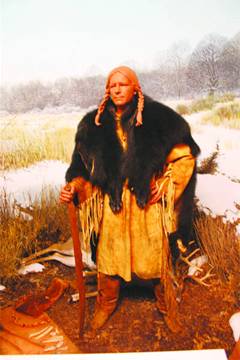6650 E. Broadway • Mt. Pleasant, MI 48858
Phone: 989-775-4750 • Fax: 989-775-4770
Hours Of Operation

A walk through history: Ziibiwing Cultural Center
Written by Rob, on 02-29-2008 22:04
MOUNT PLEASANT, Mich. - Midwest Living magazine calls the Ziibiwing Cultural Center the Midwest's top American Indian museum.
"Take a walk in our shoes," reads the welcome to this remarkable site opened in the spring of 2004. It tells the story of the Saginaw Chippewa Indian tribe of Michigan - the Anishinabek people of the Great Lakes.

A black bear fur robe and buckskin clothing, worn during the cold months of winter, represent the success of a hunt. Photo by Fred Granger. Perhaps most telling is the Anishinabemowin language, spoken throughout the center. It's the sound of proud people intent on reclaiming and holding tight their heritage, and on sharing it with others. Beginning with the word Ziibiwing, which means "place by the river," the center invites all to become immersed in the Chippewa/Ottawa/Potawattomi culture and language.
Tour guides, upon request, lead visitors on a journey through not only time but also place, providing a first-person pronunciation primer as they introduce words from their language. The words, with their English equivalents, are posted prominently on placards along each step of the way.
There are the seasons, beginning with spring: mnookimi, niibing, digwaagi, boon. Wild ricing: manoominikekamigak. Birchbark: wiigwaas. Sugarbush: ziisibaakodokaaning.
"In our research room is our immersion room, where people can learn our language," said visitor services representative Chuck Butzin. On specific weekdays, staff members provide an introductory course in the language to anyone interested.
Butzin said knowledge of the language is continually growing at the center, with more and more words being added to the staff members' repertoire and, thus, to that of visitors.
He said the Anishinabemowin language is considered a foreign language in some colleges. "I don't know why they consider it a foreign language, but they do. I took it for college credit through Native American language, our language."
Tours have been tailored to specific groups "from little tiny tots to red-hatters" and have focused on genealogy, history, religion, education and environment. Guides bring out artifacts in a show-and-tell fashion - furs, birchbark, baskets - for a hands-on learning opportunity.
Most of the time, however, tours are self-guided. Visitors walk through the history of the Anishinabek from the East Coast, where they lived along the Atlantic seaboard from what is now Nova Scotia to the Carolinas, to the Midwest. In 900 A.D. they began their Great Walk to the Great Lakes area, following the Seven Prophecies.
Exhibits introduce visitors to the prophecies, the significance of wild ricing and the sugarbush, the importance of family, the despair of broken treaties, the reclamation of the native language. They focus on the struggle to hold on to their land, their language, their life ways.
The story includes negatives in the relationship between the tribes and the "light-skinned people."
As Butzin came to a photo of some of his ancestors at a treating-signing, he pointed to gifts of flour, corn, sugar - and alcohol.
"At a treaty-signing not too far from here, over 300 barrels of whiskey were given out," he said. "Not after the signing to celebrate, not during, but days before. Now why would they want to give out that much alcohol before a signing? To get them drunk and trick them into signing more land away."
He continued with what he called "the first time the United States government used a weapon of mass destruction."
It was the use of blankets infected with smallpox.
"They gave them to our people as goodwill gifts or as treaty payments," he said. "As a result of that, a third to half of our people died."
Of particular interest is the boarding school system, which put Indian children in white schools far from their families in an effort to "kill the Indian, not the man." Anything related to the Native American culture was forbidden - clothing, hair style, language, religion, customs.
Butzin said, "Our children were taken, and I do mean taken, and put in boarding schools. At the age of 5 they were put there. They were forbidden to speak the language or they'd be punished, brutally."
The philosophy, said Butzin, was "to strip the children of everything that made them and put in what 'we' want. This went on for over 100 years. It wasn't a normal education."
The policy has been discontinued, but its legacy continues.
"I can tell you how it affected me," said Butzin. "My mother never went there, but my grandfather did. Growing up, I never hugged my grandparents. Never hugged them, never got hugs, and I thought that was horrible. I talked to my mother when I realized that wasn't normal. She can count on one hand the number of times she hugged her father. Do you think these children got loving embraces from the (school) workers? So when they grew up and became parents, they passed on what they knew - strict orders."
He said it's the reason he doesn't know his native language. His grandfather did; in fact, it was his grandfather's first language. But when he went away to the boarding school, he was forbidden to speak his native tongue.
The idea of Native Americans telling their story, of tying their past to their present and then their future, is perhaps 40 years old.
"In the 1960s the native people started standing up for their rights," said Butzin.
The future is highlighted at the Seventh Prophecy, which says that the "New People will rise up and the Anishinabek nation will be reborn. The New People will seek knowledge from their elders and rekindle the old ways."
It also says that "all people must choose between two paths - desecration or compassion."
Elizabeth Granger is a Fishers resident. She can be reached at
goneagain@insightbb.com
Opinions may not reflect those of the Noblesville Daily Times.




